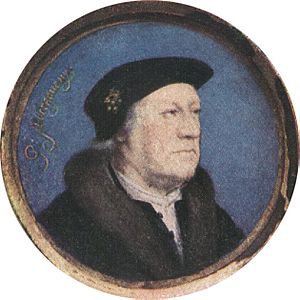George Nevill, 5th Baron Bergavenny facts for kids
Quick facts for kids
The Lord Bergavenny
|
|
|---|---|

George Nevill, 5th Baron Bergavenny, by Hans Holbein the Younger (collection of the Earls of Pembroke)
|
|
| Lord Warden of the Cinque Ports | |
| In office 1534–1534 |
|
| Preceded by | Sir Edward Poyning |
| Succeeded by | Sir Edward Guilford |
| Personal details | |
| Born | c.1469 |
| Died | June 1535 (about 66) |
| Resting place | Birling, Kent |
| Spouses | Joan FitzAlan Margaret Brent Mary Stafford Mary Brooke |
| Children | Henry Nevill, 6th Baron Bergavenny John Nevill Thomas Nevill Elizabeth Nevill Jane Nevill Mary Nevill Katherine Nevill Margaret Nevill Dorothy Nevill Ursula Nevill daughter whose name is unknown |
| Parents |
|
George Nevill, 5th Baron Bergavenny (born around 1469 – died 1535) was an important English nobleman. His family name is often spelled Neville. He was a trusted member of the royal court. He also held the important job of Lord Warden of the Cinque Ports. This role meant he was in charge of several important port towns in England.
Contents
Family Background of George Nevill
George Nevill was the son of George Nevill, 4th Baron Bergavenny. His mother was Margaret Fenn. She was the daughter of Hugh Fenn, who managed money for the English government.
George had a younger brother named Sir Thomas Nevill. Thomas was a close advisor to King Henry VIII. He also served as the Speaker of the House of Commons.
George Nevill's Public Life
George Nevill started his public life early. In 1483, he was a second cousin to the new Queen, Anne Nevill. He attended the coronation of King Richard III. Even though he was young, he was made a knight during this event. Being knighted was a special honor given by the king.
In 1492, George inherited his father's title and lands. This made him the 5th Baron Bergavenny. He became well-known in 1497 for fighting against the Cornish rebels. This battle was called the Battle of Blackheath.
Later in 1497, he joined the House of Lords. This was an important part of the English Parliament. He also became part of the King's Privy Council. This meant he was a close advisor to the King. He was often at court, which was the King's official residence.
In 1506, George faced a big problem. He was fined a huge amount of money, £100,000. This was because he had his own private army, which was against the law. He was also not allowed to travel. However, when Henry VIII became king in 1509, George was pardoned. The large fine was cancelled.
By 1512, he was back on the King's council. In 1513, he was chosen to join the Order of the Garter. This is a very old and important order of knights. That same year, he took part in military actions. He helped capture the city of Tournai and relieve the town of Guînes.
At the coronation of King Henry VIII, George had a special role. He was the Chief Larderer. This meant he was in charge of the King's food supplies. In 1512, he was given the castle and lands of Abergavenny.
George Nevill enjoyed jousting, which was a popular sport for knights. He went with both King Henry VII and King Henry VIII to important state events. These included meetings with other European rulers. In 1520, he was at the famous Field of Cloth of Gold. This was a grand meeting between King Henry VIII and King Francis I of France. He also met Emperor Charles V at Gravelines.
In 1521, George faced trouble again. His father-in-law, Edward Stafford, 3rd Duke of Buckingham, was accused of serious wrongdoing. George was then put in the Tower of London for a year. He admitted that he had known about some of the Duke's actions. He lost his official jobs and was fined again. He also had to sell his house to the King. However, he was later pardoned. He was allowed to continue serving the King. He could still be in Parliament and fight in wars.
In 1530, George signed a petition. This petition asked Pope Clement VII to allow King Henry VIII to end his marriage to Catherine of Aragon. After this, he was allowed to buy back his house. At the coronation of Anne Boleyn in 1533, he again served as Chief Larderer.
George Nevill made his will on June 4, 1535. He passed away shortly after, around June 13 or 14, 1535. He was buried in Birling, Kent. His heart was buried in Mereworth.
Marriages and Children
George Nevill was married four times.
His first wife was Joan. She was the daughter of Thomas FitzAlan, 17th Earl of Arundel. They had two daughters:
- Elizabeth Nevill, who married Henry Daubeney, 1st Earl of Bridgewater.
- Jane Nevill, who married Henry Pole, 1st Baron Montagu.
His second wife was Margaret Brent. They married before 1513. They did not have any children.
His third wife was Mary Stafford. They married around 1519. She was the youngest daughter of Edward Stafford, 3rd Duke of Buckingham. With Mary, George had three sons and five daughters:
- Henry Nevill, 6th Baron Bergavenny
- John Nevill
- Thomas Nevill
- Mary Nevill, who married three times.
- Catherine Nevill, who married Sir John St Leger.
- Margaret Nevill, who married twice.
- Dorothy Nevill (died 1559), who married William Brooke, 10th Baron Cobham.
- Ursula Nevill, who married Sir Warham St Leger.
His fourth wife was Mary Brooke. She was pregnant when he passed away. They had one daughter whose name is not known. Mary Brooke was also a cousin of Queen Anne Boleyn.
Images for kids




